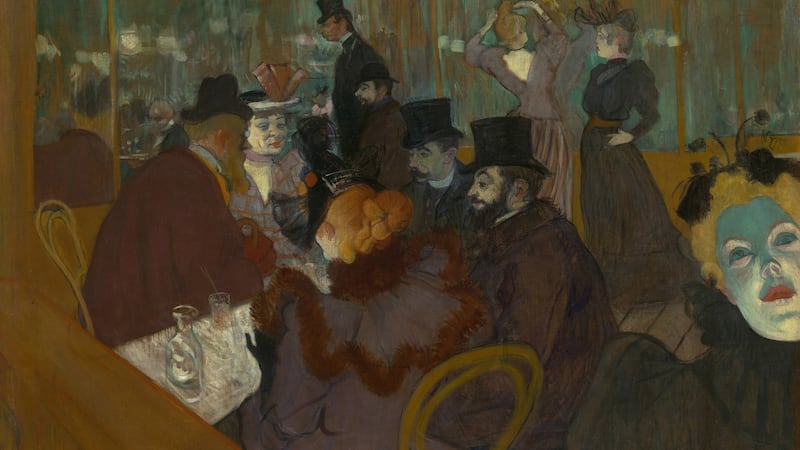Paris in the 1890s. The Moulin Rouge is the most famous cabaret in Montmartre. Every evening there, a very short, bearded man wearing a pince-nez, bowler hat, silk cravat and dark suit is greeted warmly by staff and patrons.
Everyone knows Henri de Toulouse-Lautrec. He is the soul of Montmartre, hobbling up the village’s steep streets with his cane, sketching from a corner table in the cafes and dance halls.
Lautrec is the scion of an aristocratic family, transplanted to a place synonymous with sensuality and excess. It is largely due to his paintings, lithographs and posters that the Montmartre of la Belle Époque is remembered.
Stéphane Guégan is co-commissioner of the exhibition Toulouse-Lautrec, Resolutely Modern, at the Grand Palais until January 27th. He tried to get away from the cliche of Lautrec as chronicler of the Belle Époque, a term that was in any case invented much later, after the first World War, for a period that in retrospect appeared to have been happy.
“Lautrec’s ambition was much greater, and the exhibition proves it,” Guégan says. “He observed the mores and inventions of his time with ironic, somewhat biting distance.”
Lautrec immortalised the stars of Montmartre in dozens of posters, with simple, sure lines and vibrant colours. The images are eminently recognisable: songwriter Aristide Bruant's black hat and red scarf; singer Yvette Guilbert's black gloves; the motion of dancer Jane Avril, frozen in time.
Need for speed
Lautrec was fascinated by speed. He painted racehorses, automobiles and bicycles, as well as the fast-moving legs of dancing girls.
Lautrec’s parents, Count Alphonse and Countess Adèle, were first cousins who separated when he was four. Henri suffered from a congenital disease that stunted his growth and doomed him to a short life. Like his father, he was a bon vivant with an insatiable sexual appetite. But he remained close to his solitary, religious mother.

At the age of 18, Lautrec decided on a career as a painter. He left his mother’s chateau to enroll at Fernand Cormon’s atelier in Montmartre. There he met Vincent van Gogh, who became his fast friend and drinking buddy. When Van Gogh took his own life in 1890, Lautrec wrote a moving letter to the painter’s brother Theo.
In her book Mistress of Montmartre: A Life of Suzanne Valadon, the British author June Rose described Lautrec: "That he was ugly, almost grotesque, was undeniable; his nose was large and bulbous, his lips thick and flabby and his chin covered in a black stubbly beard. He was a little less than 5ft high, his body normal-sized but with short, knock-kneed legs and powerful truncated arms with crabby fingers."
Yet despite his appearance, “Lautrec had self-assurance, aristocratic authority”, says Guégan. “He was not a man defeated by life. On the contrary. He found the means to satisfy his desires. I do not detect the slightest sign of existential woe in him.”
Romantic attachments
Unlike his friend Degas, Lautrec did not keep a diary or write of his exploits, so art historians are uncertain of his romantic attachments. He painted a redhead called Carmen Gaudin many times. And he is believed to have had an affair with Valadon, his neighbour and fellow painter. Her real name was Marie-Clémentine, but because Valadon posed nude for old men, Lautrec rechristened her Suzanne, after the biblical story of a bathing woman who was spied on by elders.
Selling sex was tolerated in late 19th-century Paris. By 1900, there were 127 brothels in Montmartre. Lautrec was an habitué of the one at number 6, rue des Moulins. “There is no place where I feel more at home,” he said. The women there treated him with affection, like a mascot. He painted them talking to clients, eating in the canteen and waiting for the regulatory medical visit.
Lautrec's art was supported by the avant-garde Revue Blanche. In 1895, when Oscar Wilde was on trial for homosexuality in Britain, the Revue published an article in Wilde's favour. Lautrec provided illustrations for the article, and he also drew a portrait of Wilde for the opening of his play Salomé. Lautrec showed similar understanding towards lesbians. And though he was apolitical, some of his friends were anarchists.
Lautrec invented a cocktail called The Earthquake, mixing cognac and absinthe. He suffered from alcoholism, syphilis and tuberculosis.
Lautrec’s family sent him to a clinic in Neuilly to dry out, to no avail. Guégan believes he made a deliberate choice to continue drinking rather than renounce a pleasure. He died in his mother’s arms, at the age of 36.










